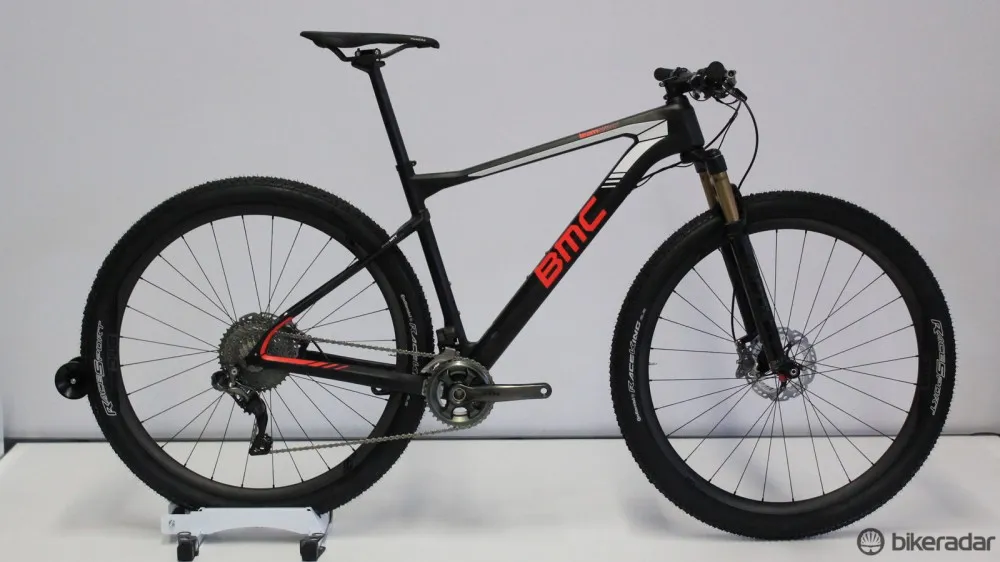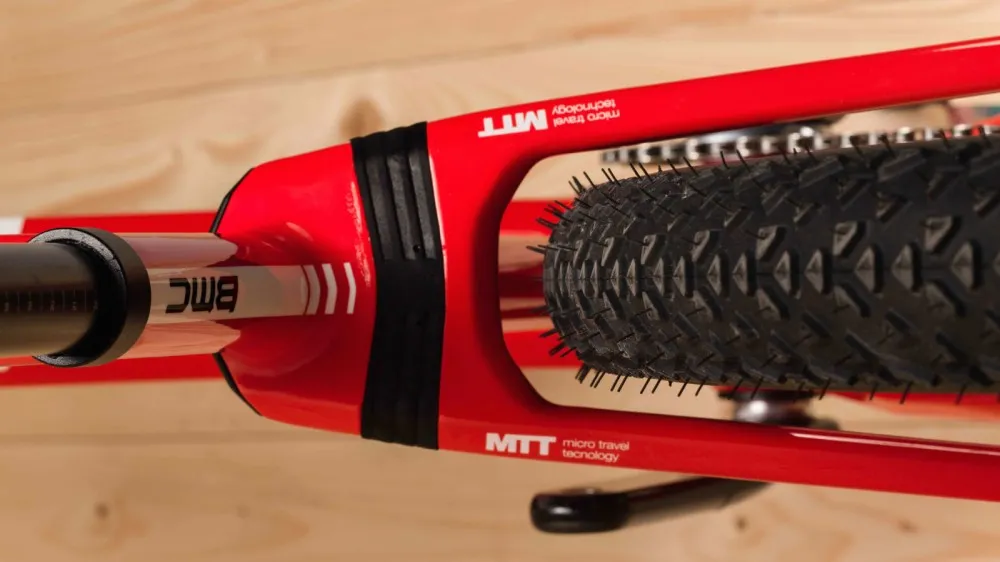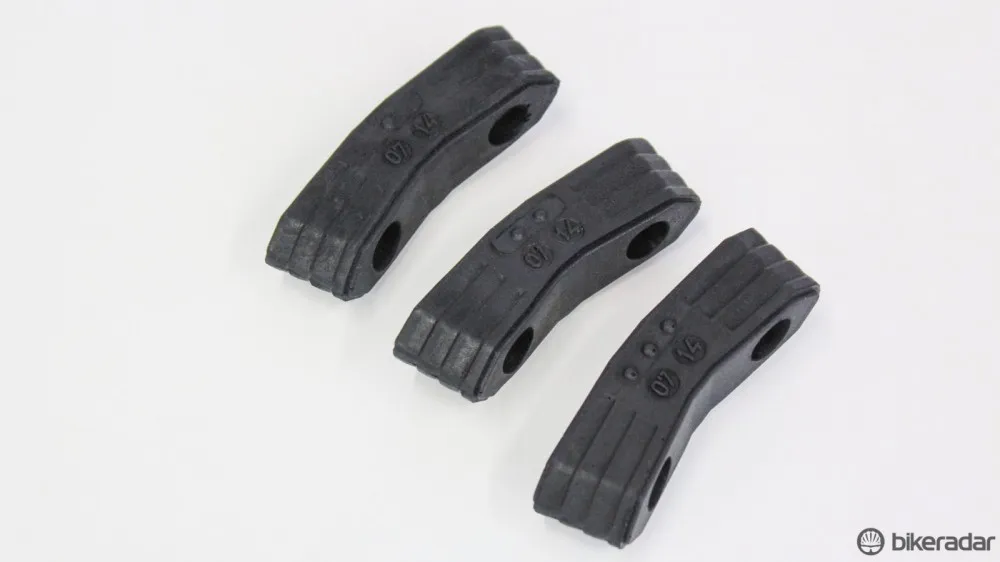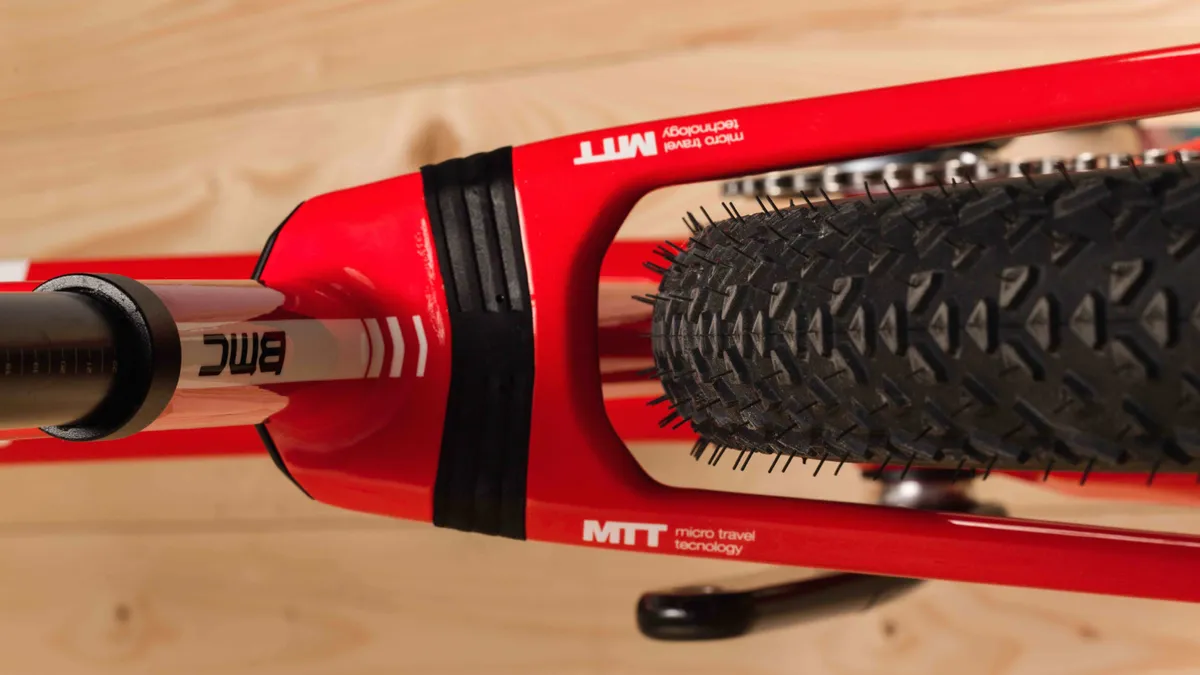Despite the prevalence of lightweight and efficient full-suspension machines, cross-country racers still look to their hardtails when the track demands it. Hardtails might be light and fast, but they offer little chance to recover when the trail turns downwards. With the release of the new Teamelite 01 hardtail, BMC believes it has managed to combine the low weight and high efficiency of a hardtail with even greater traction and comfort by using an elastomer sandwiched between the seatstays and seat tube of the all-carbon frame. Dubbed Micro Travel Technology, it gives around 15mm of vertical rear wheel movement for a weight penalty over the old Teamelite frame of 140g, giving a respectable total of 1,175g for a medium frame.
BMC states that this new Teamelite is not designed to supplant full-suspension bikes, but to improve the traction and comfort of its top-end racing hardtail. Geometry and front travel is unaltered from the 2014 bike, sharing the same 100mm fork, long top tube (610mm for a medium), slack-for-a-race bike 70 degree head angle and short 429mm chainstays, while retaining the ability to run a front derailleur. BMC will offer the new Teamelite in a wider range of sizes, with the new XS model giving 85mm more standover clearance than last year’s small.

The Di2-equipped model is similar to what Julien Absalon will ride in 2016
Top-end is exactly what this bike is, too, with the frame-only option starting at €3,399 / US$3,599. Complete bikes start with an 11spd Shimano XT build coming in at €4,399 / US$4,599, A SRAM XX1-equipped model at €5,999 / US$6,599 and the top level Shimano XTR Di2 model pushing the limits at €9,999 / US$10,599. (UK and Australian pricing has yet to be announced.)
How does it work?
The biggest component is obviously the elastomer. Elastomers may be a thing of the past in most other full suspension designs, but they’re a good call in this very low travel application. There’s no seal friction to overcome, dirt doesn’t affect them and they’re very light. They also have a naturally self-damping property called hysteresis, getting rid of some of their energy when they decompress as heat. As anyone who owned an old suspension fork that used elastomers can attest, they are somewhat sensitive to temperature, becoming less springy as they get colder. Their very nature means that they’ll happily flex in all directions, so to prevent lateral play, the system uses two hard anodised studs that thread into the seatstays through a pair of DY bushings, just like the ones you’d find on a traditional shock’s eyelets. BMC claims this means there’s no loss of lateral stiffness over the previous rigid frame. It also means the elastomer can be changed to suit rider weight or preference, with hard, medium and soft versions included with every bike. Dirt ingress is prevented with a pop-on plastic cover. BMC recommends that the system be cleaned, greased and checked after every 30hrs of riding, with worn bushings replaced as necessary. BMC dealers will be sent the bushing tools free of charge. We managed to field strip and change the elastomer in less than five minutes, the only tools needed were a screwdriver and 6mm hex key.

The rear end offers 15mm of elastomer-sprung suspension
Developed in its Swiss-based IMPEC facility, the bike came about when their team riders, including current world champion Julien Absalon, asked if the existing bike could be made more compliant in order to stave off fatigue. After rig testing the existing frame and looking at their carbon layups, BMC's engineering team realised the simplest solution was simply to cut a section out of the seatstay of the Teamelite frame. They rapidly prototyped a number of different designs to prove the concept before ending up with this production bike, but it’s more than a cut and paste job. The final bike uses very different chain- and seatstay profiles in order to direct the flex without affecting the fatigue life of the bike. They took the new frame off the fatigue-testing rig after no failure or change of response after two million cycles (the standard test is 100,000 cycles). Obviously, long term, real world use will prove just how durable the system is, especially when it comes to the tough life of a privateer race bike.
The BMC team did extensive testing with their racers using power-meter equipped bikes combined with speed and heart rate data to try and see what affect the new system had. They didn’t have hard data on hand, so we can’t say for sure, but they reckon that the outcome was actually a more efficient bike. Although the fact they’ve got a damped spring means that some energy is getting absorbed by the elastomer, the fact that the small amount of give improves traction by keeping the wheel in contact with the ground longer would seem to bear this out. After all, a spinning or slipping wheel is wasting energy, and having to ease up over roots or rocks because you’re worried about slipping or puncturing doesn’t make you go any faster.
First impressions:
Our early production test bike was outfitted with a mix of kit, but were essentially the same as the XTR Di2 complete save for the wheels, which were shod with alloy DT Swiss rims (instead of BMC’s own carbon wheels) and wrapped in Continental Mountain King IIs set up tubeless. The 100mm Fox Factory 32 fork had an electric iCD remote and a single shifter controlled the double-ring Di2 setup. The production Di2 bike tips the scales at 9.25kg/20.4lb and the XX1 bike at 9.09kg/20.04lb.
There’s little to signal the difference between this bike and the old Teamelite thanks to neat integration, but once on the trail, it’s instantly apparent that something different is afoot at the rear end. At first, there was a definite sensation of movement at the back, but as the bushings began to bed in, the feeling of having something loose and wobbly in the back end began to disappear.
A spin on the road to the trails didn’t give much indication of bobbing or strange behaviour, but with just 15mm of travel, that’s barely surprising. However, when tarmac turned to dirt and then rapidly to wet, root-infested singletrack I could feel a very real muting of the rough kick that a stiff carbon hardtail can give you when pedalling seated over rough ground. The old frame design was remarkably compliant for a carbon race bike, but this is a step ahead, especially as it retains the compliance of a narrow diameter 27.2mm carbon post.
While BMC were talking up the descending benefits of the design, it’s out of the saddle climbing on choppy or lose ground where I felt big increases in traction. The standard compound Mountain King II tyres aren’t my favourites for grip in the wet – the opposite, in fact – but it felt like I was running a softer compound or greater volume bit of rubber, save for the fact there was no loss of acceleration.
Acceleration was present by the bucket, too, but instead of spitting traction during out of the saddle, lung-rasping sprints, the rear put power to forward motion with a real dedication of purpose. I'm a fan this bike's progressive geometry. The riding position is spot on, with very little of the twitchiness or front end tuck I've come to expect on top level racing machine in corners. That’s good, because once I'd had a few runs of a steep, fast and greasy test loop, I started to really push the speed past tentative, puncture-wary first attempts. Where I expected to hear the sound of rim meeting ground, I just skipped off the top of roots and rock at warp speed. It’s relentless and the faster you ride, the better it seems to work.

Three durometer inserts will be included with every bike
After experimenting with different durometer inserts, I finally settled on the softest — much to the surprise of this test rider, who prefers any form of suspension to be set up hard and supportive. That’s partly because unlike a squidgy fork or shock, there’s no real bottom out sensation and the travel is so limited it doesn’t affect cornering response. It’s just a tiny little bit of extra leeway when it comes to grip and comfort, both uphill and down, and neither extreme seemed to alter the pedalling efficiency to any degree.
Many of the factory BMC racers have apparently come to a similar conclusion, with most running the softest insert. If I would have had time (and enough spare tubes) then I’d have liked to play with tyre pressures to see whether it allows lower pressures; though one could argue that kind of misses the point of a system that gives comfort and grip without excess drag.
I'm going to withhold judgement on just how this bike rates against similarly speedy and capable race bikes, such as the superb Cannondale F-Si, until I've run one for long enough to compare the long-term durability or performance in a wider range of conditions. My initial impression is that the BMC Teamelite 01 is staggeringly fast. It breathes new life into what to many seemed like a dying breed. It’s by no means cheap, but it really does perform. I've got a feeling that the Shimano XT-equipped bike will be a serious hit when it comes to racers trying to balance price versus performance. Bikes should be landing in shops around June, stay tuned for a full test on a production bike coming soon.













